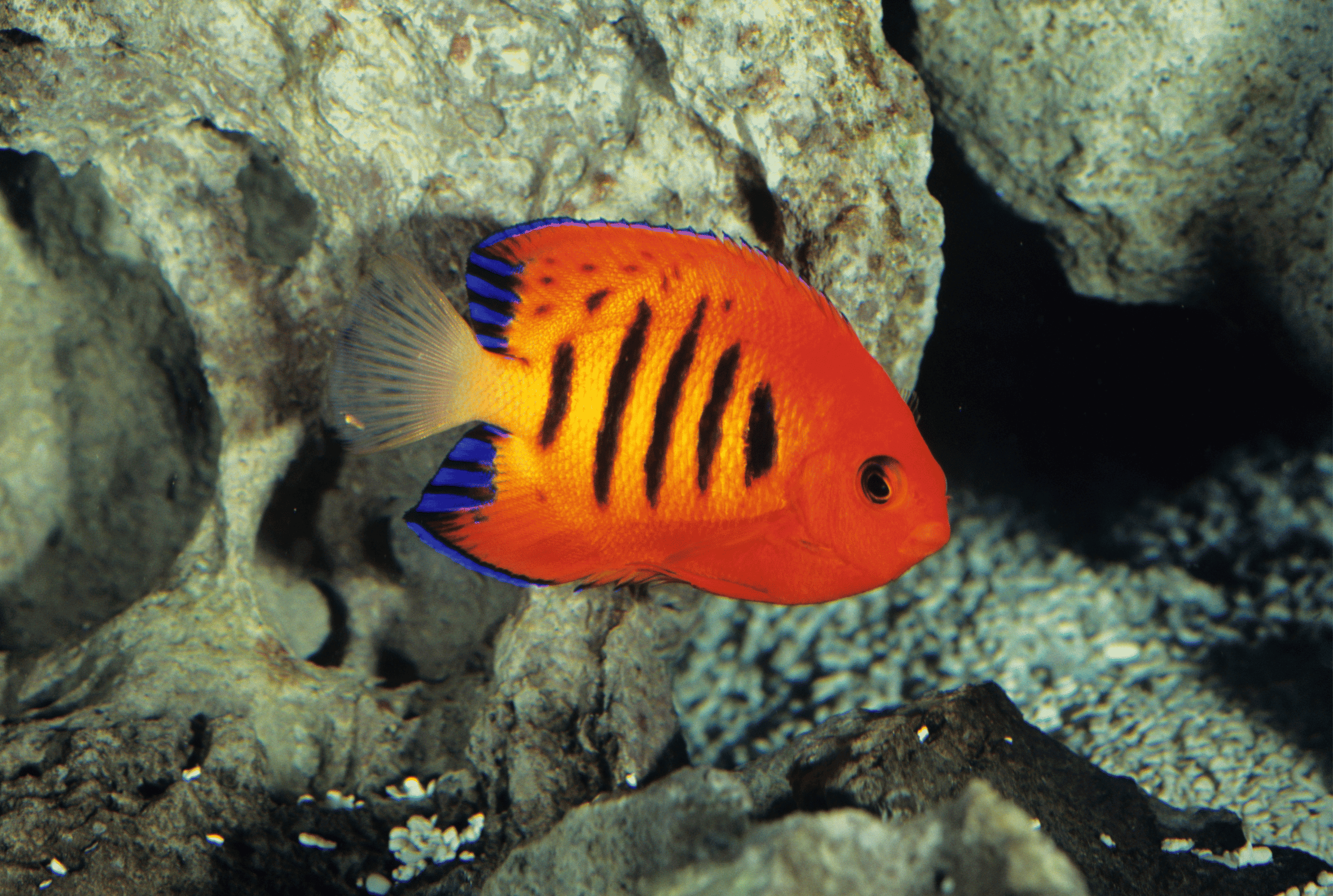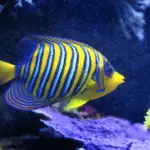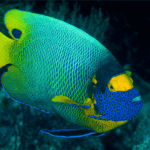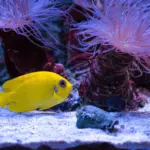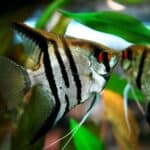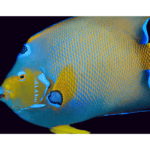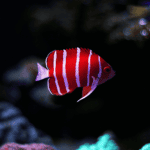The Flame Angelfish, a vibrant dweller of the tropical seas, stands out with its fiery red to orange coloration combined with vertical black stripes and a blue-tipped dorsal fin. Scientifically recognized as Centropyge loricula, this small member of the Pomacanthidae family captivates aquarists and marine enthusiasts alike. Originating from the warm waters of the Pacific, including the Great Barrier Reef and Hawaiian Islands, their striking appearance and active demeanor make them a popular choice for home aquariums.
Understanding the specifics of their care is crucial for maintaining their health and vibrancy in captivity. They require a well-established tank with plenty of live rock for grazing and hiding. Due to their territorial nature, the Flame Angelfish should be housed with caution around other tankmates, especially members of their species or similar looking fish. Optimal conditions and a varied diet are paramount for this species’ longevity and coloration. While their breeding in captivity is rare, advances in marine aquaculture techniques offer hope for aquarists interested in their lifecycle.
Key Takeaways
- Flame Angelfish are characterized by their bright coloration and preference for a warm, reef-rich environment.
- Careful attention to aquarium conditions and diet is essential to maintain their health.
- Although predominantly territorial, proper tank management can ensure compatibility with other species.
Physical Description
In discussing the Flame Angelfish, we immediately notice their vibrant appearance and distinct size differences between the sexes. These details are not just fascinating; they’re critical for identification and understanding the species’ biology.
Distinctive Coloration
The Flame Angelfish is renowned for its striking orange-red to deep red body color, which is where its name is derived. We observe vertical black stripes on its sides that enhance its bold profile within its habitat. Additionally, a noteworthy black spot appears on the posterior end, near the base of the soft dorsal fin. It is this exquisite coloration that distinguishes it from other marine angels.
Size and Sexual Dimorphism
On average, these angelfish reach an adult size of about 4 inches (10 cm). In terms of sexual dimorphism, males typically are slightly larger and showcase more pronounced coloration compared to females, which may be less vivid in appearance. The size of a fish can be a modest indicator of its sex, but it’s not always conclusive without observing breeding behaviors.
| Feature | Size |
|---|---|
| Average Adult Length | 4 inches (10 cm) |
Please note that sexual dimorphism is fairly subtle in this species and may not be easily discerned by size alone.
Natural Habitat and Distribution
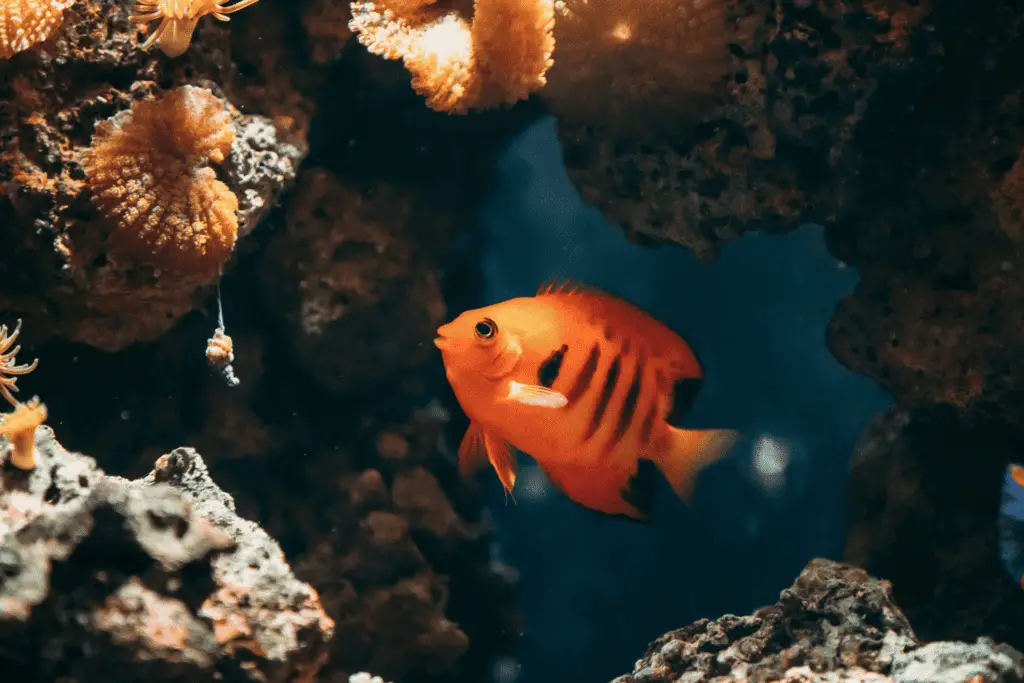
The Flame Angelfish thrives in the warm, shallow waters of the Pacific, specifically within coral reef ecosystems. We find this fish favoring regions of strong current where they can access a rich diversity of food sources.
Reef Associations
Flame Angelfish are most commonly associated with reef environments that offer both food and protection. They are adept at navigating the complex structures of coral reefs, which provide abundant niches and shelters. These fish have a symbiotic relationship with the reefs, contributing to the ecosystem by grazing on algae which helps maintain the health and balance of the coral habitats.
Preferred Habitats:
- Shallow lagoons
- Subtidal reefs
- Protected seaward reefs
Depth Range:
- Typically between 5 and 60 meters (16 to 197 feet)
Geographical Range
The geographical distribution of the Flame Angelfish spans a vast area of the Indo-Pacific region, including several island territories. The key locations where they are found include:
- Central Pacific: Aquatic regions around Oceania, including the Marshall Islands and the Cook Islands.
- East Pacific: Populations reaching to the Marquesas.
- Oceanic Distribution:
- Predominantly Centropyge loricula is seen in the Pacific Ocean, flourishing in the tropical waters of the Indo-Pacific belt.
A detailed understanding of the habitats and distribution of the Flame Angelfish aids in maintaining their populations both in the wild and in reef aquariums around the world.
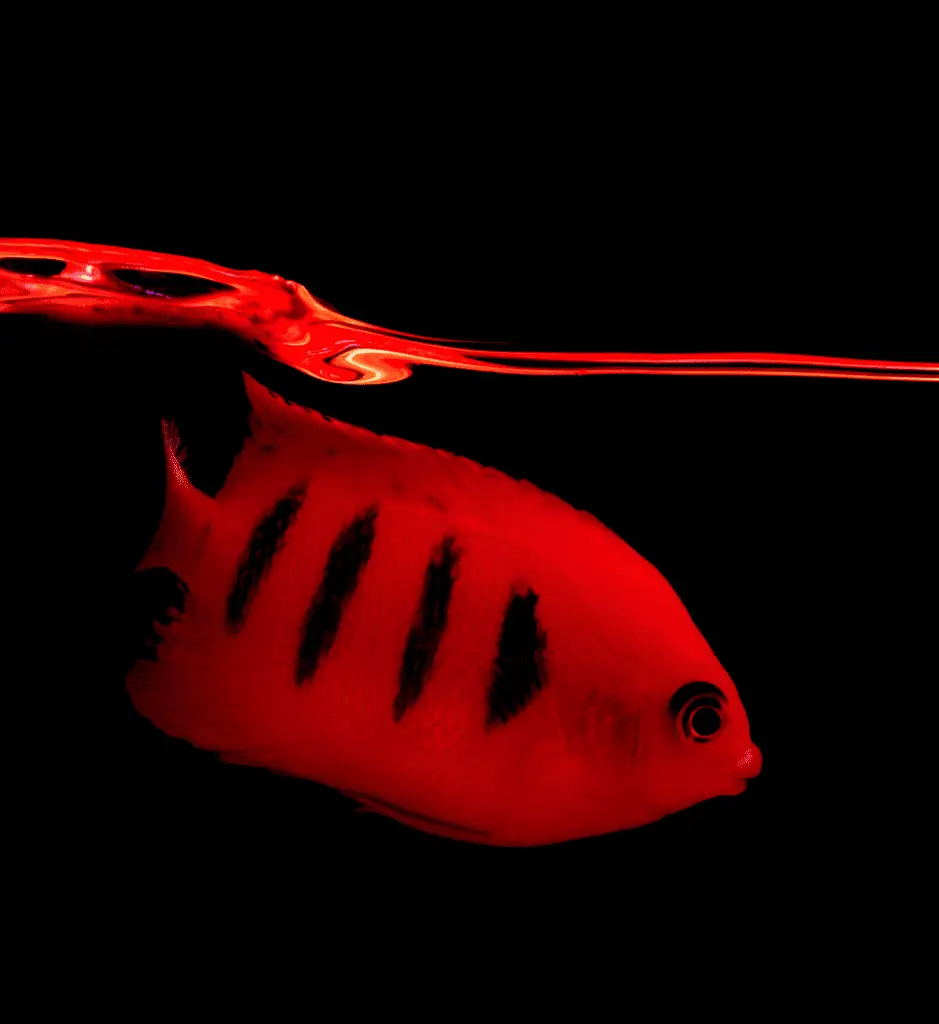
Care Requirements
Proper care for a Flame Angelfish involves providing optimal aquarium conditions, an appropriate diet, and monitoring for health issues. By maintaining these aspects diligently, we ensure the well-being of these vibrant saltwater fish.
Aquarium Conditions
Tank Size:
- Minimum of 30 gallons for a single Flame Angelfish.
Water Parameters:
- Temperature: 72°F to 82°F (22°C to 28°C).
- pH Level: 8.1 to 8.4.
- Specific Gravity: 1.020 to 1.025.
- Water Hardness: Opt for moderately hard water.
Tank Setup:
- Provide plenty of live rock for grazing on natural algae growth.
- Establish a tank environment with moderate to strong water flow.
Compatibility:
- Flame Angelfish are semi-aggressive.
- Choose tank mates that are not overly timid or small enough to be bullied.
Feeding
Diet:
- Flame Angelfish are omnivores with a need for both meaty foods and algae.
- Feed them a varied diet that includes:
| Food Type | Frequency |
|---|---|
| Mysis Shrimp | Regular Part of Diet |
| Brine Shrimp | Occasionally |
| Seaweed Sheets | Staple Part of Diet |
| Spirulina | Often Mixed with Foods |
| Pellets (specially formulated for marine omnivores) | Alternate to Fresh Foods |
- It is critical to provide algae within their diet to prevent nutritional deficiencies.
Health and Diseases
Common Diseases:
- Watch out for saltwater ich (marine ich), which is a common ailment.
Prevention:
- Quarantine new arrivals to prevent the spread of diseases.
- Maintain stable water parameters, as fluctuations can stress the fish and lead to disease susceptibility.
Care Level:
- Flame Angelfish are considered hardy, but they still require consistent care to prevent health issues.
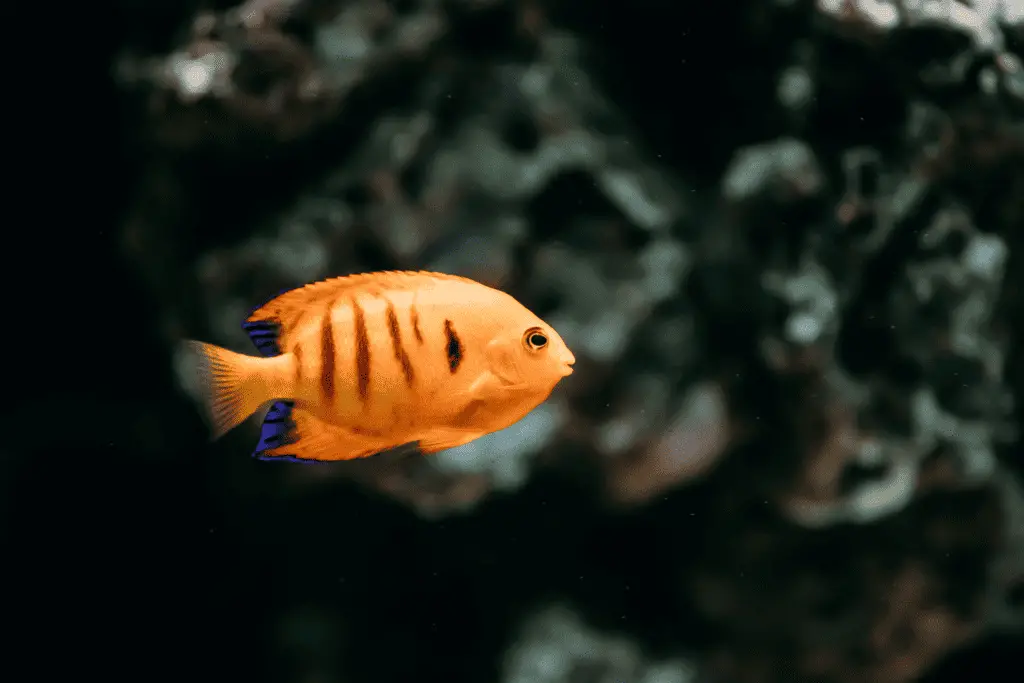
Behavior and Compatibility
In discussing the Flame Angelfish, a striking highlight is its distinctive social structure and necessary compatibility considerations for a harmonious aquarium.
Social Behavior
Our examination of the Flame Angelfish’s temperament reveals a complex social behavior. These fish are inherently territorial and can exhibit aggressive tendencies, especially when housed in smaller tanks or with many of their kind. In the wild, they often live solitarily or in pairs, but in an aquarium setting, they may be kept in a harem consisting of one male and several females. This grouping can reduce aggression if the tank space allows for it.
- Tankmates: Choosing tankmates for the Flame Angelfish should be done with care; compatible species are generally those that are peaceful and can hold their own without encroaching on the Flame Angelfish’s territory.
- Reef Compatibility: While these angelfish are enchanting, they are not always reef-safe. They have been known to nip at soft and stony corals as well as some clam species. However, a well-fed specimen in a spacious and enriching environment may exhibit less destructive behavior.
It’s essential to monitor their interactions with other inhabitants and adjust the tank dynamics as needed. Our knowledge indicates that with proper space, environmental enrichment, and a balanced social structure, the Flame Angelfish can coexist peacefully with a variety of tankmates.
Breeding and Lifecycle
In this section, we will explore the specific aspects of breeding flame angelfish in captivity and discuss their typical lifespan and stages of development.
Breeding in Captivity
Breeding flame angelfish in captivity is a challenging process but can be successful with careful attention to their environment and needs. We must first ensure a well-established reef tank, replicating their natural habitat with optimal water quality parameters for successful breeding. Diverse cover including live rock and coral for hiding and spawning sites is critical. Pairs should be introduced carefully, as flame angelfish can be territorial. Spawning typically occurs on a flat surface where the female can lay her eggs, and the male will then fertilize them. Proper care during this process is vital, as the eggs are sensitive to water conditions.
- Water Parameters:
- Temperature: 75-80°F (24-27°C)
- pH: 8.1-8.4
- Salinity: 1.020-1.025
Lifespan and Development
The lifespan of flame angelfish in captivity typically ranges from 5 to 7 years, given proper care and a well-maintained environment. After hatching, the larvae go through a planktonic stage before metamorphosing into juveniles. During this period, they require a diet rich in zooplankton to survive and grow. As the flame angelfish matures, it develops its vibrant coloration and characteristic patterns, transitioning into a diet more focused on algae and meaty foods. Regular monitoring and proper tank maintenance ensure a healthy development throughout their lifespan.
- Key Development Stages:
- Planktonic Larvae Stage: Requires zooplankton.
- Juvenile Stage: Coloration and pattern development.
- Adult Stage: Shift in diet preference, territorial behavior becomes prominent.
Frequently Asked Questions
In this section, we address some of the most common queries regarding the care and requirements of Flame Angelfish, providing you with straightforward and informed answers.
What is the ideal tank size for a Flame Angelfish?
For a single Flame Angelfish, a 30-gallon tank is typically the minimum size recommended. However, if housing multiple fish or considering a reef setup, a larger tank of 55 gallons or more will be necessary to provide adequate swimming space and territorial range.
What are suitable tank mates for a Flame Angelfish?
Flame Angelfish should be housed with other peaceful or semi-aggressive species to maintain a harmonious environment. Suitable tank mates include clownfish, dwarf angels, gobies, and dottybacks. They should not be kept with aggressive species that may bully or harm them.
What is the scientific name of the Flame Angelfish?
The scientific name of the Flame Angelfish is Centropyge loricula.
What does a Flame Angelfish’s diet consist of?
Flame Angelfish have a varied diet that should include marine algae, spirulina, mysis shrimp, and other high-quality frozen preparations. It’s vital to ensure they receive a mix of meaty foods and vegetables for their overall health.
How does the Flame Angelfish coexist with corals?
Flame Angelfish can coexist with corals, but with caution, as they may nip at soft and stony coral polyps or clam mantles. When well-fed, the likelihood of them bothering corals decreases. It’s important to observe their behavior to prevent any coral damage.
What is the average cost of a Flame Angelfish?
The cost of a Flame Angelfish typically ranges from $30 to $60, but prices can vary based on size, coloration, and regional availability. It’s advisable to purchase from reputable sources that offer healthy and sustainably sourced fish.
